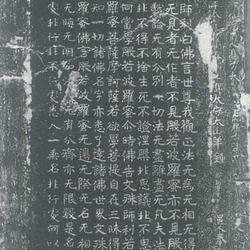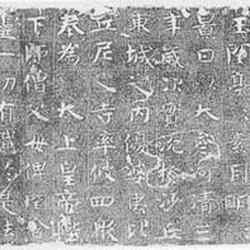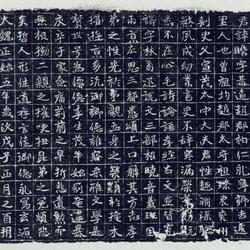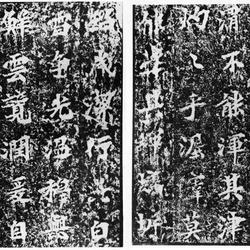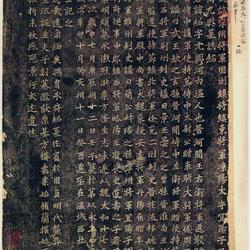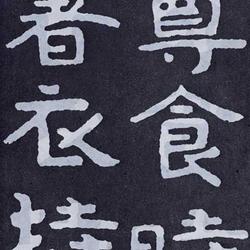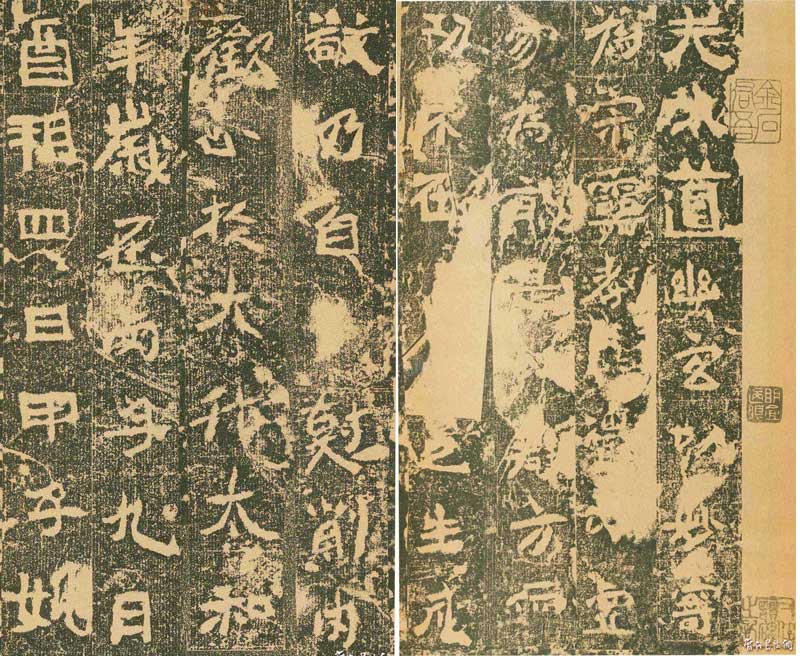
"Yao Boduo's Statues" is also known as "Yao Wenqian's Statue Stele" and "Yao Boduo Brothers Made Stone Statues". Yao Boduo's statue stele is the earliest Taoist statue stele known so far. It was written in the 20th year of Taihe in the Northern Wei Dynasty (AD 496). It is 1.30 meters high, 0.30 meters thick, and 0.72 meters wide. The top base is missing, but the tenon marks are still there, and there are carvings on all sides. In 1936, it was moved to Yaoxian Stele Forest and is now stored in Shaanxi Yaoxian Museum. It was listed as the first batch of national key cultural relics protection units together with other stone carvings in Yaowang Mountain.
This stele is inscribed on all sides, and there are 624 characters on the front. There is a shadow on the stele, and the strokes are thin and unique. This stele is a Taoist statue stele. The inscriptions and carvings on the statues are very special. The pens used are square and round, with some hidden and some exposed. The style of the calligraphy is in both regular script and official script, and the physical structure is also very different from ordinary regular script and official script. The size and oblique changes of the fonts are very free and lively, making it appear simple and childish. But he can see the cleverness in the clumsiness, the clumsiness in the cleverness, and it is unique. The author of the Book of Immortals may have been someone from the lower class who was proficient in writing, so there are many different words. Judging from the uneven lines and uneven sizes in the stone carvings, it seems that the inscriptions were not written on the stone but were directly carved on the stone with a knife instead of pen. It appears to be very natural and harmonious, with a natural interest, and there is also a sense of wonder between the lines. Personality is a unique product of Northern Dynasties calligraphy. Yu Youren once praised this stele, together with the "Guangwu General Stele" and "Murong En Stele" as "the three unique steles in Qinzhong".
appendix:
Research on the names of the main figures of the Taoist statues of Yao Boduo in the Northern Wei Dynasty
Li Song
The Yao Boduo statue stele is the earliest Taoist statue stele known so far. It was made in the 20th year of Taihe in the Northern Wei Dynasty (AD 496). It is now in the Shaanxi Yaoxian Museum. It is listed among the first batch of stone carvings along with other stone carvings in Yaowang Mountain. National key units. The information on this stele has been published twice. The first time was in 1965 in the magazine "Archaeology", which published "A brief history of stone carvings in Yaoxian County", which was introduced briefly①. The second time was in the magazine "Archaeology and Cultural Relics" in 1987, which published the article "Taoist statue stele in Yaowang Mountain, Yao County", which introduced it in more detail②. Both introductions ignored—or rather failed to solve—a very important question: the name of the main deity of Yao Boduo’s statue stele, that is, what god does the Yao stele enshrine?
When introducing the Yao stele, "A Brief History of Stone Carvings in Yaoxian County" only excerpted a short section of the core text from the stele's aspiration, saying: "On September 4, the 20th year of Taihe (496), Yao Boduo, Bolong, and Ding Brother Long built a stone statue of the emperor's ancestor for the family members of the seventh ancestor." There is no other text③. Here, Yao Boduo has actually mentioned the name of the statue he made, but we are not familiar with it and need to do some research.
The article "Taoist Statue Stele at Yaowang Mountain in Yao County" introduces the stele in more detail and appends all the vows. The article first elaborates on the name of the statue of Yao Monument, saying:
"In the middle of the niche is a statue of 'Huang Xianjun Wen'. Who is 'Wen' is unknown... Yao highly praised the statue of 'Huang Xianjun Wen'... Wen wears a Taoist crown, with ears and long neck. , the clothes are not revealing. Put your hands in front of your abdomen, sitting in lotus position... "The Continuation of the Shaanxi Provincial Annals" only contains the frontal vows of Yao stele. In its appendix, "The emperor's article is said to be" The words "Buddha" and "Buddha" are engraved on the front are incorrect."④.
According to the above meaning, the owner of Yao stele is revered as "the stone statue of Huangxianjunwen", and furthermore, as "Huangxianjunwen", that is, the "wen" person. Sure enough? Let’s talk about literacy first. There are many characters on stele inscriptions in the Northern Dynasties that are difficult to read. The reason is that strokes were randomly added and even the glyphs were changed. The so-called "Xian" character in this stele is an example. Among the five characters in the inscription "Huangxianjun Wenshi", only the so-called "Xian" is quite suspicious. According to its actual strokes, the character is written as " ", and the font is regular script and official script. Probably because the glyph is similar to the word "Xian", both introductions read it as "Xian" (I did not read it carefully in an article and did not read the original stele, so I continued to use this word) 5.
What is the word " "? I think it is " ", which means "old".
There are two common ways of writing the word "老" in the Northern Dynasties inscriptions, one is " " and the other is " ". The latter character " " is composed of two characters: old man. "Yan's Family Instructions Miscellaneous Collection" says: "The ancestors called him Lao." In the surviving Northern Dynasties stele inscriptions, all the characters """ are read as old. The famous Japanese Chinese character dictionary "Kadokawa Calligraphy Dictionary" lists five Northern Dynasties inscriptions and epitaphs (namely, Zhang Menglong stele in the Northern Wei Dynasty, Li Bi's epitaph, Zhang Ning's epitaph, The epitaph of King Yan of the Eastern Wei Dynasty, the statue of Liu Bei of the Northern Qi Dynasty, etc.), in all five cases, the word "老" is written as " "⑥. The author also found this word on a statue stele in the Lintong County Museum, Shaanxi Province, that is, the statue of Xiaochang in the Northern Wei Dynasty. Stele. The main niche of the stele is a Taoist statue, holding a fan, wearing a Taoist crown and a Taoist robe. There is a line of characters engraved on the right side of the main niche, the upper end of which is broken, followed by "Tai Shangjun One Body", which should be "Tai Shang Lao" There is no doubt that "Jun". Another example is the Taoist statue stele of Maren cast in the Northern Zhou Dynasty in the Forest of Steles in Xi'an. The inscription on the stele is called "the area where statues of Mr. Shi are built", and "Lao" is also written in the same way. In official script or regular script and official script, it is more casual The handwriting of the word "人" is often written as " " or " ", followed by two or three strokes. This writing method continues to this day and is considered to be a common way of writing the word "人" in an irregular way. We are all very familiar with it. We are familiar with it, so there is no need to argue. Therefore, the character "Qiao" in the Yao stele is the character " ", and the main character of the Yao stele should be the "stone statue of Huang Laojun" instead of "the late emperor".
"Emperor" refers to the monarch, that is, the Supreme Being. "Book of Han" 44 "Biography of King Li of Huainan" Bo Zhao and Changshu: "The king does not understand the reason why the country is safe and secure in the past and present, but wants to look to the Supreme Being as a relative, which is not possible." Yan Shigu notes " For example, Chun said: "The Supreme Being is the Son of Heaven"⑦. In view of this, "Huang Laojun" can be interpreted as "Tai Shang Laojun". This is consistent with the main statue of Lintong Xiaochang's three-year statue.
So, what is the interpretation of the word "文"? I think there are two interpretations to choose from.
First, it is related to "Sakyamuni Buddha". Sakyamuni, Sanskrit Dialectic Sakyamuni, also translated as Sakyamuni, and abbreviated as Sakyamuni, Sakyamuni, and Sakyamuni. The annotation in "Prince Ruiying Benqi Jing" says: "The text of Sakyamuni, the language of Tianzhu, Sakyamuni is Neng, the text is Confucianism, and the righteous name is Nengru." Obviously: "Sakyamuni" is a more accurate transliteration. The translation of "Sakyamuni" is probably a transliteration that takes into account the intrinsic connection between "wen" and "confucianism" and has both a meaning and a meaning. In the Buddhist statues of the Southern and Northern Dynasties, the term Sakyamuni Buddha is often used. For example, "The statue of Sakyamuni was completed in the fourth year of the Liang Dynasty" says: "Disciple Kang Sheng was determined to build a stone statue of Sakyamuni", while other statue steles often refer to it as "Statue of Sakyamuni". It seems that "Sakyamuni Statue" and "Sakyamuni Statue" have the same meaning, and the word "文" may be a dispensable word. Since the statue of Sakyamuni is the statue of Sakyamuni, then isn't the "stone statue of Huang Laojun" the "stone statue of Huang Laojun"? Taoists followed the practice of Buddhists and added a little "" to Taishang Laojun's name" The tail of "Wenru". Just as the word "wen" in "Shakyamuni" does not need to be investigated, the "wen" in "Huang Laojun Wen" does not need to be investigated.
There is another possibility that I think is more reasonable, that is, the word "文" is interpreted as its original meaning. The original meaning of "wen" is the interlacing of colors, patterns and textures. "Book of Rites·Legends of Music": "The five colors make the writing without chaos." The second part of "Yi·Xici" says: "It has made people famous and famous, so they don't want others to write embroidery." Since "wen" is made of five colors, Aren't "aragonite statues" just painted stone statues? Looking at the original Yao monument, the three seated statues of the main statue and the four standing statues of the side attendants are all very simple. The outline of the main statue's facial features can still be seen clearly, but the limbs and body are very simple. Each is represented by a raised circular bar shape. As far as the modeling language of relief art is concerned, it seems that it cannot be simpler. Examining the current status of the statue and the relationship between the statue and the intact stone, we can believe that the original was not damaged due to damage. In other words, the existing thing cannot be too far removed from the original thing. However, the Yao family's evaluation of such a simple statue was unexpectedly high. In their vows, they praised the statue:
"The structure and decoration of the building are the work of exquisite craftsmen. They hide the shape and form as if the true appearance is now present in this world. They rely on the system of the dome to create a pure and beautiful appearance, as if it were true." The benevolence and principles are neither vertical nor biased. Their pictures are jade and jade, and the colors are intertwined. The mountains are connected to each other."
There is a big gap between Yao's comments and the actual objects. How to understand this phenomenon? I think there is a supplementary link: painting. The deficiencies in the sculptures are made up for by painting. Today, 1,500 years later, all the colors have faded away, so what we see are not the original colors.
Painting on sculptures is a long-standing tradition in the history of Chinese sculpture (the same applies to ancient Greece and Egypt). The distant ones are like the Qin and Han pottery figurines underground, and the more recent ones are like the clay sculptures of Mogao Grottoes and Yungang stone carvings on the ground. It is a combination of sculpture (carving) and painting. Judging from the carving conditions of the bas-relief figures on the side of Yao Boduo's stele, it can be seen that the craftsmen of Yao Boduo's stele had the skills of the portrait stone craftsmen of the Eastern Han Dynasty, but they lacked the corresponding experience and experience when carving the high-relief sculptures (main niche statues). Techniques, of course they would use traditional methods to paint rough stone shapes, and they might even apply thin mud and then paint them (this was the practice of some Buddhist statues in the Northern Dynasties), in order to achieve the effect of "what if the true appearance is now alive" Imagery requirements. This is the painted stone statue - aragonite statue.
Therefore, I believe that the so-called "stone statue of the emperor's ancestor" is not a statue of the "emperor's ancestor" named "Wen", but a painted stone statue of Taishang Laojun, which is the main statue of Yao Boduo's statue stele. If the above inference is true, we have found the earliest extant statue of Taishang Laojun in China (although the statue of Wei Wenlang is earlier than the Yao stele, the identity of the Taoist statue is not clear - see the author's other article ⑧).
There is another example that supports the argument of this article. In 1958, a painted stone Taoist statue was unearthed in Bin County, Shaanxi Province. The statue is 43 centimeters high. The Taoist statue is in a seated shape, holding a fan in its right hand and a disabled left hand. It wears a Taoist crown on its head, a double-lapel Taoist robe and a belt around its waist. The back is engraved with lotus patterns and flame patterns, with a flower on each side and two horses at the bottom. The whole body of the stone statue is painted, with an orange face, white hair, blue robes, alternating red and green lotus flowers, black horses, and orange flame patterns. There are inscriptions on the back and both sides of the stone statue, including the words "the third year of the founding of the Emperor" and "Bai Xianjing built a Taoist statue" ⑩. The sculpture of this statue (the second year of Emperor Kaihuang's reign is 583 AD) is less than a hundred years after the statue of Yao Boduo. Bin County is located in the west of Guanzhong and Yao County is located in the north of Guanzhong. The two places are not far apart. Due to historical reasons, the statue of Bai Xianjing has been preserved and painted, which can be used as a reference for us to understand Yao Boduo's stele. In other words, the bright colors painted by Bai Xianjing should be the prototype of Yao Boduo's stele.
Note:
①③Yao Sheng, "A brief history of stone carvings in Yao County", "Archaeology" Monthly, Issue 3, 1965, page 134.
②④Han Wei and Yin Zhiyi, "Taoist statue stele in Yaowang Mountain, Yao County", "Archaeology and Cultural Relics", Issue 3, 1987, page 18.
⑤ Li Song's "Several Basic Issues in Northern Dynasties Taoist Statues in Guanzhong Area." published in "Research on Art History", to be published by Lingnan Fine Arts Publishing House.
⑥ (Japan) "The Great Dictionary of Calligraphy" compiled by Fushimi Okikei, published by Kadokawa Shoten, Tokyo, Showa 49, page 1781.
⑦ "Twenty-Five Histories", Shanghai Ancient Books Publishing House, Shanghai Bookstore, page 566.
⑧Li Song, "Research and Supplementary Research on the Wenlang Statue Stele of the Northern Wei Dynasty", "Wenbo" bimonthly, Issue 1, 1994, page 52.
⑨The author once mistook the two horses in this statue for two donkeys in an article and saw "a Taoist statue stele of the Qiang people in the Northern Wei Dynasty". "Chinese Taoism" 1994 Issue 3, Page 32.
⑩Wang Renbo, editor-in-chief, "The Essence of Cultural Relics of the Han and Tang Silk Roads", page 156, Long Publishing (Hong Kong) Co., Ltd., 1990.

